ALMA’s Acute View of pPNe: Through the Magnifying Glass... and What We Found There
Abstract
1. Introduction
2. A Quest for Rotating Disks in Post-AGB Objects
3. Nebular Architecture and Dynamics of pPNe: The ALMA View of OH 231.8+4.2
3.1. Observations
3.2. Continuum Maps
3.3. Molecular Line Maps: Nebular Components
3.4. Conclusions
Author Contributions
Funding
Conflicts of Interest
References
- Maercker, M.; Mohamed, S.; Vlemmings, W.H.; Ramstedt, S.; Groenewegen, M.A.; Humphreys, E.; Kerschbaum, F.; Lindqvist, M.; Olofsson, H.; Paladini, C.; et al. Unexpectedly large mass loss during the thermal pulse cycle of the red giant star R Sculptoris. Nature 2012, 490, 232–234. [Google Scholar] [CrossRef] [PubMed]
- Balick, B.; Frank, A. Shapes and Shaping of Planetary Nebulae. Annu. Rev. Astron. Astrophys. 2002, 40, 439–486. [Google Scholar] [CrossRef]
- Soker, N. Formation of Bipolar Lobes by Jets. Astrophys. J. 2002, 568, 726–732. [Google Scholar] [CrossRef]
- Frank, A.; Blackman, E.G. Application of Magnetohydrodynamic Disk Wind Solutions to Planetary and Protoplanetary Nebulae. Astrophys. J. 2004, 614, 737–744. [Google Scholar] [CrossRef]
- Van Winckel, H. Post-AGB Stars. Annu. Rev. Astron. Astrophys. 2003, 41, 391–427. [Google Scholar] [CrossRef]
- Bujarrabal, V.; Alcolea, J.; Van Winckel, H.; Santander-García, M.; Castro-Carrizo, A. Extended rotating disks around post-AGB stars. Astron. Astrophys. 2013, 557, A104. [Google Scholar] [CrossRef]
- Bujarrabal, V.; Neri, R.; Alcolea, J.; Kahane, C. Detection of an orbiting gas disk in the Red Rectangle. Astron. Astrophys. 2003, 409, 573–580. [Google Scholar] [CrossRef]
- Bujarrabal, V.; Castro-Carrizo, A.; Alcolea, J.; Van Winckel, H.; Sánchez Contreras, C.; Santander-García, M.; Neri, R.; Lucas, R. ALMA observations of the Red Rectangle, a preliminary analysis. Astron. Astrophys. 2013, 557, L11. [Google Scholar] [CrossRef]
- Bujarrabal, V.; Castro-Carrizo, A.; Alcolea, J.; Santander-García, M.; van Winckel, H.; Sánchez Contreras, C. Further ALMA observations and detailed modeling of the Red Rectangle. Astron. Astrophys. 2016, 593, A92. [Google Scholar] [CrossRef] [PubMed]
- Bujarrabal, V.; Castro-Carrizo, A.; Alcolea, J.; Van Winckel, H.; Sánchez Contreras, C.; Santander-García, M. A second post-AGB nebula that contains gas in rotation and in expansion: ALMA maps of IW Carinae. Astron. Astrophys. 2017, 597, L5. [Google Scholar] [CrossRef]
- Bujarrabal, V.; Castro-Carrizo, A.; Van Winckel, H.; Alcolea, J.; Sánchez Contreras, C.; Santander-García, M.; Hillen, M. High-resolution observations of IRAS 08544-4431. Detection of a disk orbiting a post-AGB star and of a slow disk wind. Astron. Astrophys. 2018, 614, A58. [Google Scholar] [CrossRef] [PubMed]
- Bujarrabal, V.; Van Winckel, H.; Neri, R.; Alcolea, J.; Castro-Carrizo, A.; Deroo, P. The nebula around the post-AGB star 89 Herculis. Astron. Astrophys. 2007, 468, L45–L48. [Google Scholar] [CrossRef]
- Bujarrabal, V.; Castro-Carrizo, A.; Alcolea, J.; Van Winckel, H. Detection of Keplerian dynamics in a disk around the post-AGB star AC Herculis. Astron. Astrophys. 2015, 575, L7. [Google Scholar] [CrossRef]
- Kervella, P.; Homan, W.; Richards, A.M.S.; Decin, L.; McDonald, I.; Montargès, M.; Ohnaka, K. ALMA observations of the nearby AGB star L2 Puppis. I. Mass of the central star and detection of a candidate planet. Astron. Astrophys. 2016, 596, A92. [Google Scholar] [CrossRef]
- Homan, W.; Richards, A.; Decin, L.; Kervella, P.; de Koter, A.; McDonald, I.; Ohnaka, K. ALMA observations of the nearby AGB star L2 Puppis. II. Gas disk properties derived from 12CO and 13CO J = 3 − 2 emission. Astron. Astrophys. 2017, 601, A5. [Google Scholar] [CrossRef]
- Bujarrabal, V.; Castro-Carrizo, A.; Alcolea, J.; Sánchez Contreras, C. Mass, linear momentum and kinetic energy of bipolar flows in protoplanetary nebulae. Astron. Astrophys. 2001, 377, 868–897. [Google Scholar] [CrossRef]
- Alcolea, J.; Bujarrabal, V.; Sánchez Contreras, C.; Neri, R.; Zweigle, J. The highly collimated bipolar outflow of OH 231.8+4.2. Astron. Astrophys. 2001, 373, 932–949. [Google Scholar] [CrossRef]
- Bujarrabal, V.; Alcolea, J.; Sánchez Contreras, C.; Sahai, R. HST observations of the protoplanetary nebula OH 231.8+4.2: The structure of the jets and shocks. Astron. Astrophys. 2002, 389, 271–285. [Google Scholar] [CrossRef]
- Sánchez Contreras, C.; Bujarrabal, V.; Miranda, L.F.; Fernández-Figueroa, M.J. Optical long-slit spectroscopy and imaging of OH 231.8+4.2. Astron. Astrophys. 2000, 355, 1103–1114. [Google Scholar]
- Sánchez Contreras, C.; Desmurs, J.F.; Bujarrabal, V.; Alcolea, J.; Colomer, F. Submilliarcsecond-resolution mapping of the 43 GHz SiO maser emission in the bipolar post-AGB nebula OH231.8+4.2. Astron. Astrophys. 2002, 385, L1–L4. [Google Scholar] [CrossRef]
- Sánchez Contreras, C.; Gil de Paz, A.; Sahai, R. The Companion to the Central Mira Star of the Protoplanetary Nebula OH 231.8+4.2. Astrophys. J. 2004, 616, 519–524. [Google Scholar] [CrossRef]
- Matsuura, M.; Chesneau, O.; Zijlstra, A.A.; Jaffe, W.; Waters, L.B.F.M.; Yates, J.A.; Lagadec, E.; Gledhill, T.; Etoka, S.; Richards, A.M.S. The Compact Circumstellar Material around OH 231.8+4.2. Astrophys. J. 2006, 646, L123–L126. [Google Scholar] [CrossRef]
- Forde, K.P.; Gledhill, T.M. Discovery of shocked H2 around OH 231.8+4.2. Mon. Not. R. Astron. Soc. 2012, 421, L49–L53. [Google Scholar] [CrossRef]
- Balick, B.; Frank, A.; Liu, B.; Huarte-Espinosa, M. Models of the Hydrodynamic Histories of Post-AGB Stars. I. Multiflow Shaping of OH 231.8+04.2. Astrophys. J. 2017, 843, 108. [Google Scholar] [CrossRef]
- Sánchez Contreras, C.; Alcolea, J.; Bujarrabal, V.; Castro-Carrizo, A.; Velilla Prieto, L.; Santander García, M.; Quintana-Lacaci, G.; Cernicharo, J. Through the magnifying glass: ALMA acute viewing of the intricate nebular architecture of OH231.8+4.2. Astron. Astrophys. 2018. forthcoming. [Google Scholar] [CrossRef]
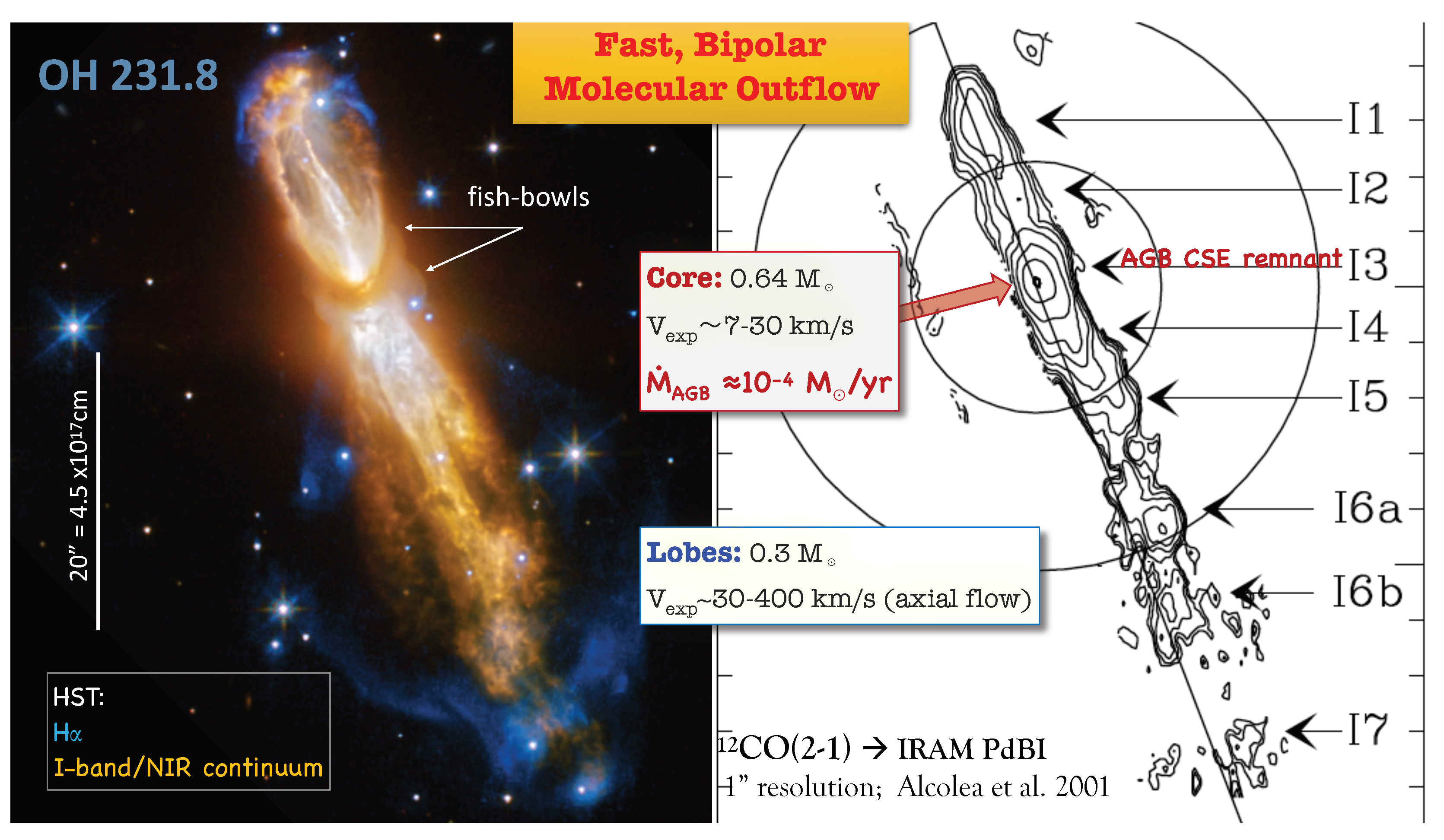
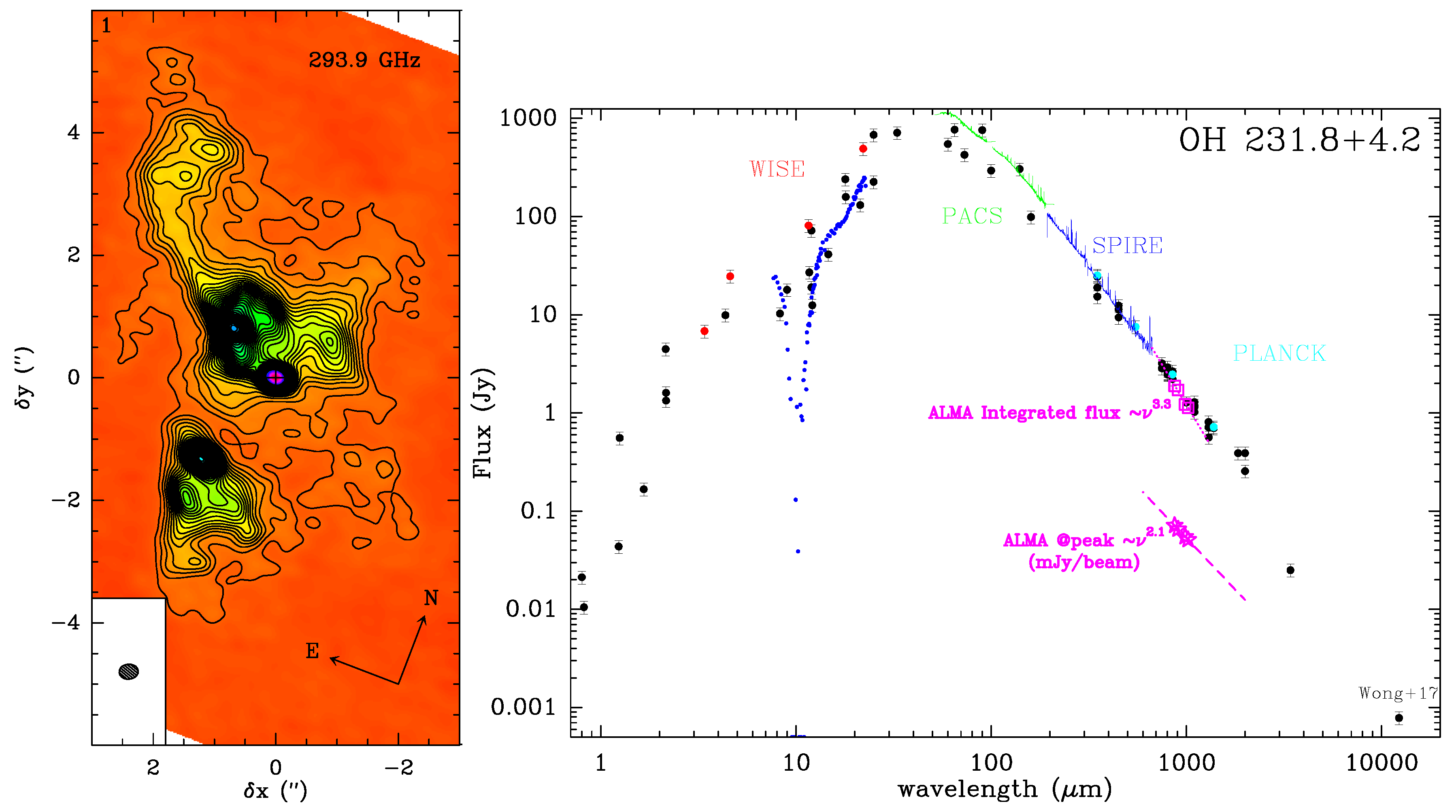
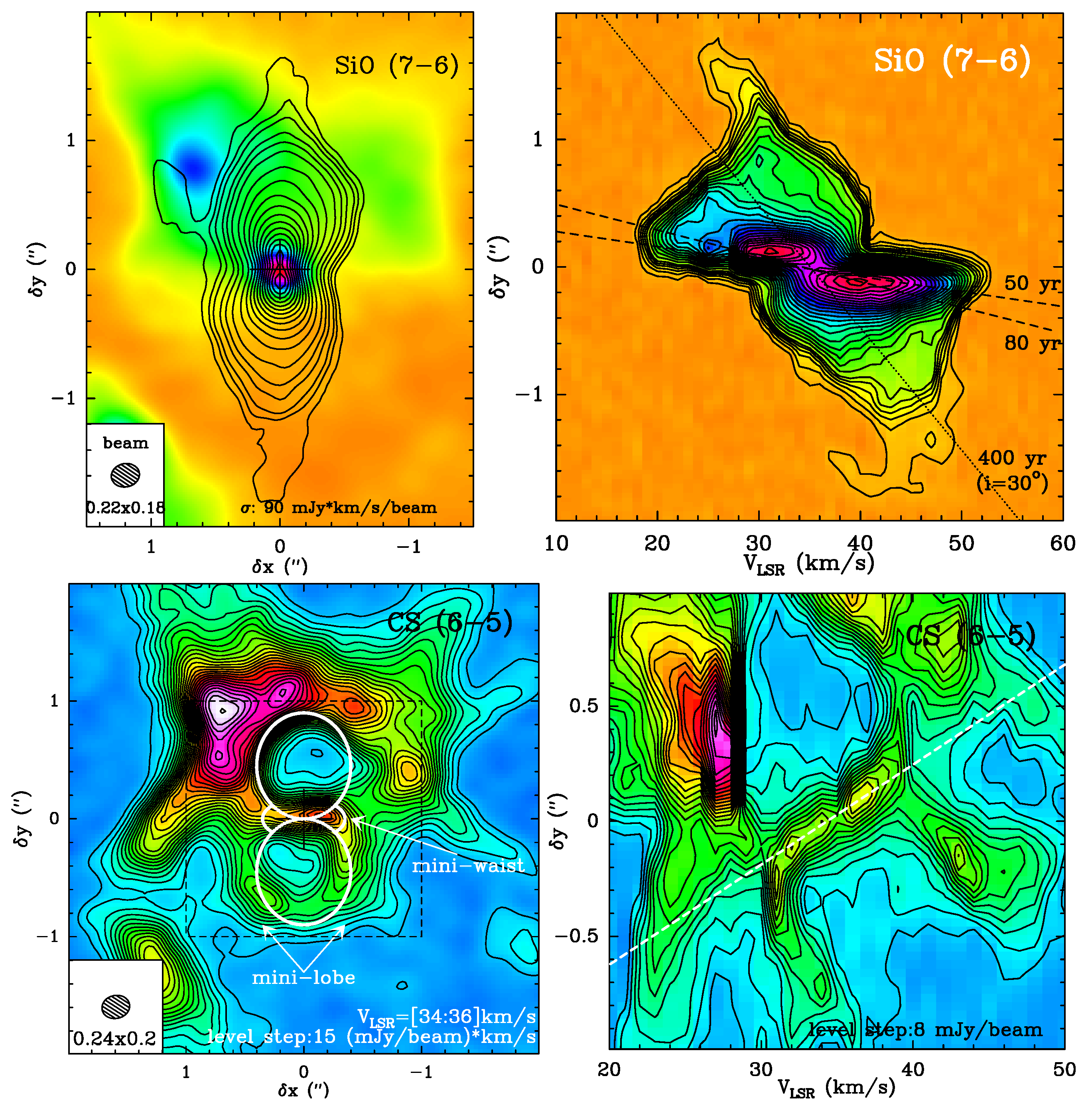
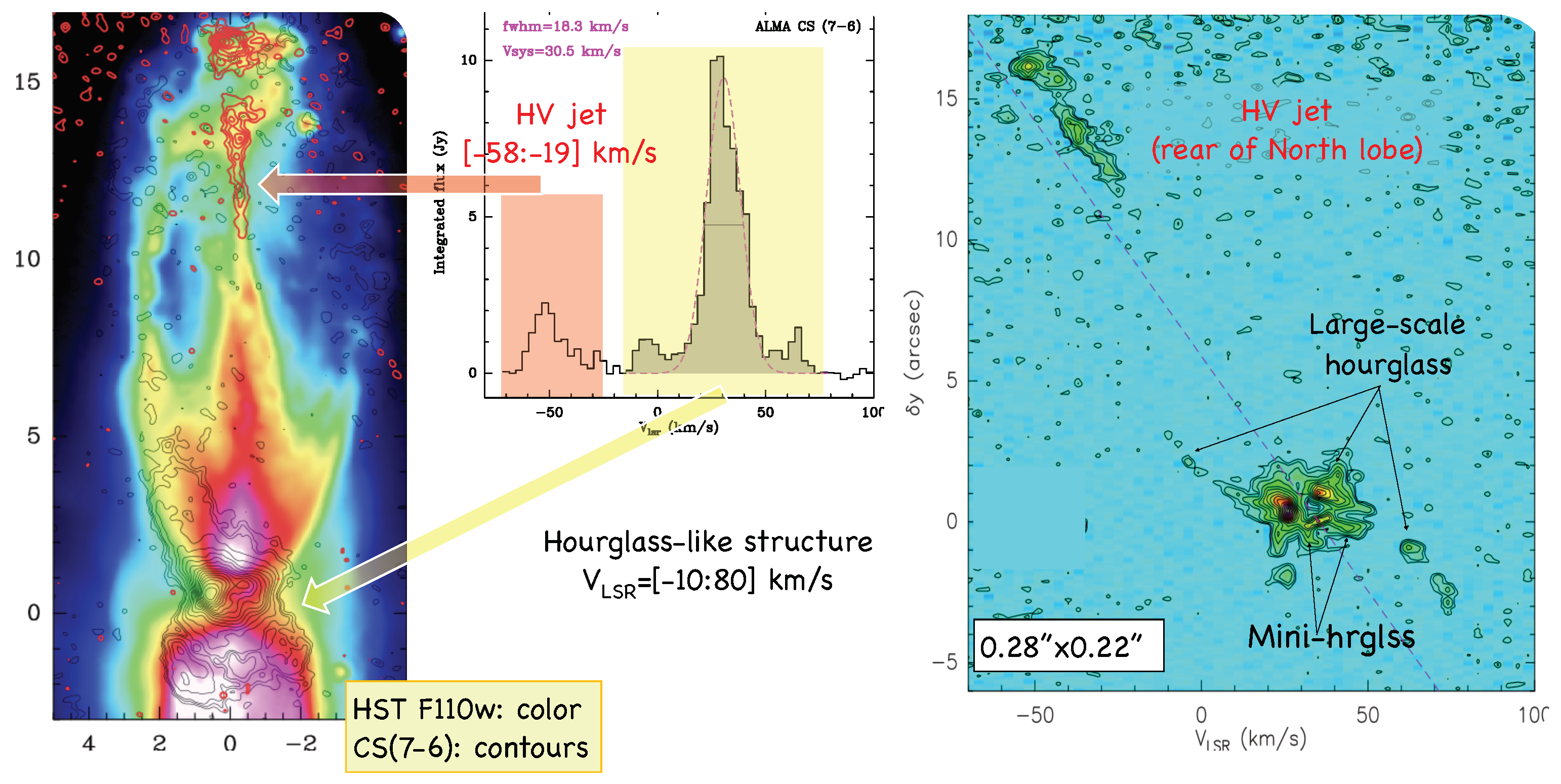
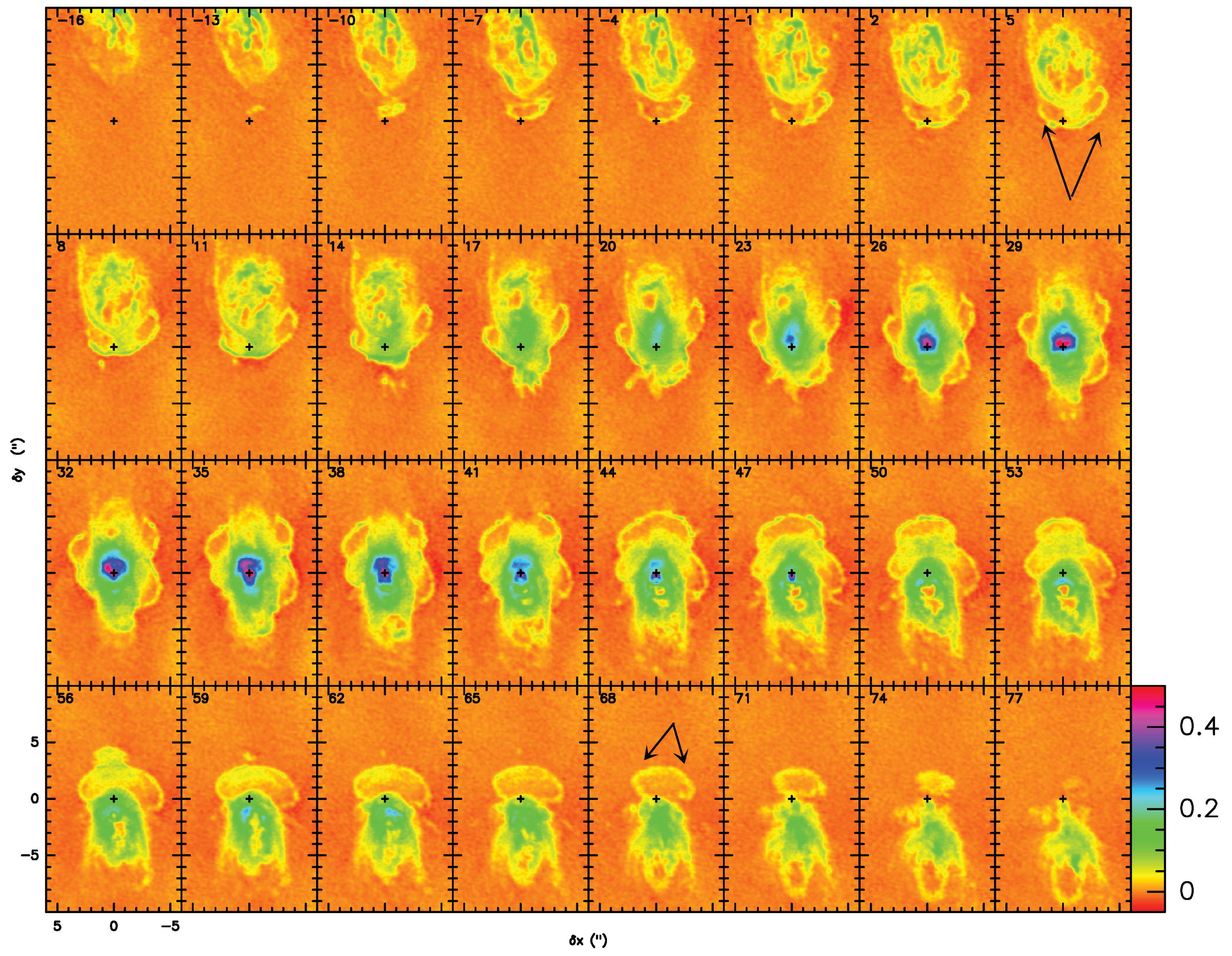
| Name | Class | Disk | X-Wind | Rdisk | Mdisk | M★ | Reference |
|---|---|---|---|---|---|---|---|
| Red Rectangle | post-AGB | Yes | Yes | ≈2000 AU | 4.0 × 10−2 | ∼1.5 | [7,8,9] |
| IW Car | post-AGB | Yes | Yes | ≈1300 AU | 4.0 × 10−3 | ∼1 | [10] |
| AC Her | post-AGB | Yes | ? | ≈1130 AU | 1.5 × 10−3 | ∼1.5 | [13] |
| IRAS 08544 | post-AGB | Yes | Yes | ≈1400 AU | 6.0 × 10−3 | ∼1.8 | [11] |
| 89 Her | post-AGB | Possibly | Yes | ≲200 AU | (∼10−2 ) | (∼1 ) | [12] |
| L2 Pup | AGB | Yes | ? | ≈20 AU | 2.2 × 10−4 | ∼0.66 | [14,15] |
© 2018 by the authors. Licensee MDPI, Basel, Switzerland. This article is an open access article distributed under the terms and conditions of the Creative Commons Attribution (CC BY) license (http://creativecommons.org/licenses/by/4.0/).
Share and Cite
Contreras, C.S.; Alcolea, J.; Bujarrabal, V.; Castro-Carrizo, A. ALMA’s Acute View of pPNe: Through the Magnifying Glass... and What We Found There. Galaxies 2018, 6, 94. https://doi.org/10.3390/galaxies6030094
Contreras CS, Alcolea J, Bujarrabal V, Castro-Carrizo A. ALMA’s Acute View of pPNe: Through the Magnifying Glass... and What We Found There. Galaxies. 2018; 6(3):94. https://doi.org/10.3390/galaxies6030094
Chicago/Turabian StyleContreras, Carmen Sánchez, Javier Alcolea, Valentín Bujarrabal, and Arancha Castro-Carrizo. 2018. "ALMA’s Acute View of pPNe: Through the Magnifying Glass... and What We Found There" Galaxies 6, no. 3: 94. https://doi.org/10.3390/galaxies6030094
APA StyleContreras, C. S., Alcolea, J., Bujarrabal, V., & Castro-Carrizo, A. (2018). ALMA’s Acute View of pPNe: Through the Magnifying Glass... and What We Found There. Galaxies, 6(3), 94. https://doi.org/10.3390/galaxies6030094





